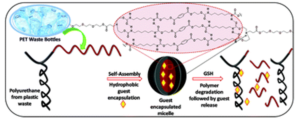Santra et al. use recycled plastic-waste derived monomers to synthesize a redox-responsive self-immolative amphiphilic polyurethane nanoassembly.
Polymeric nanoparticles have undeniably found numerous applications in fields ranging from medicine to nanoelectronics. Despite the significant progress in the area, there is an increasing demand in chemotherapeutics to construct polymeric nanoassemblies able to encapsulate and deliver cargo on-demand. Most polymeric nanocarriers suffer from uncontrolled disassembly leading to premature, non-specific guest release while often; guests need to be covalently entrapped to achieve high encapsulation stability.
To address these issues, Molla and collaborators developed a strategy that allows upcycling plastic waste to synthesize a redox-responsive, self-immolative amphiphilic polyurethane that assembles into robust, tightly packed nanoassemblies with high encapsulation efficiency and stability. More specifically the upcycled-plastic nanocontainers were equipped with aromatic moieties enhancing their stability, disulfide bonds offering redox response and tertiary amines inducing charge tunability. Triethylene glycol monomethyl ether units were periodically incorporated on the polymer to enhance hydrophilic interactions with water. Computational studies supported that the high encapsulation stability observed in these polyurethane nanocarriers stems from supramolecular cross-linking via π–π stacking and H-bonding interactions. Notably, in a redox environment 70 % of guest release was obtained from the self-immolative polyurethane nanocarriers while significantly reduced release was observed in polymers lacking the disulfide linker and polymers lacking the aromatic component. The high encapsulation stability was supported by the low leakage coefficient measured in FRET experiments. Pleasingly, zeta potential measurements revealed the generation of nanoassemblies with positive surface charge at a tumor extracellular matrix relevant pH was attributed to the tertiary amine component.
In summary, a plastic waste derived monomer was used as a basis to create robust self-immolative polyurethane nanocarriers with promising biomaterial characteristics such as biocompatibility, triggered release, and environment-specific charge modulation.
Mijanur Rahaman Molla et al., Supramolecularly cross-linked nanoassemblies of self-immolative polyurethane from recycled plastic waste: high encapsulation stability and the triggered release of guest molecules, Polym. Chem., 2022, 13, 3294-3303.
Link to the paper: https://pubs.rsc.org/en/content/articlelanding/2022/PY/D2PY00341D
 |
Dr. Kelly Velonia is an Advisory Board Member and a Web Writer for Polymer Chemistry. She joined the Department of Materials Science and Technology in 2007. Research in her group focuses on the synthesis and applications of bioconjugates and biopolymers. You can follow Kelly on twitter @KellyVelonia
|











